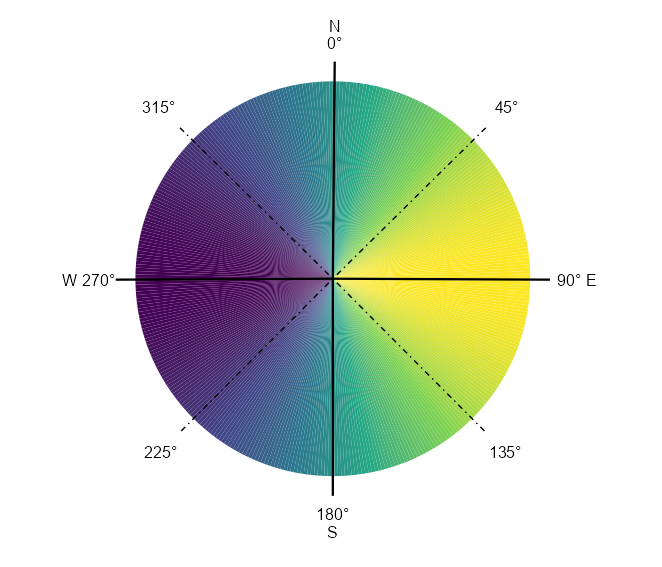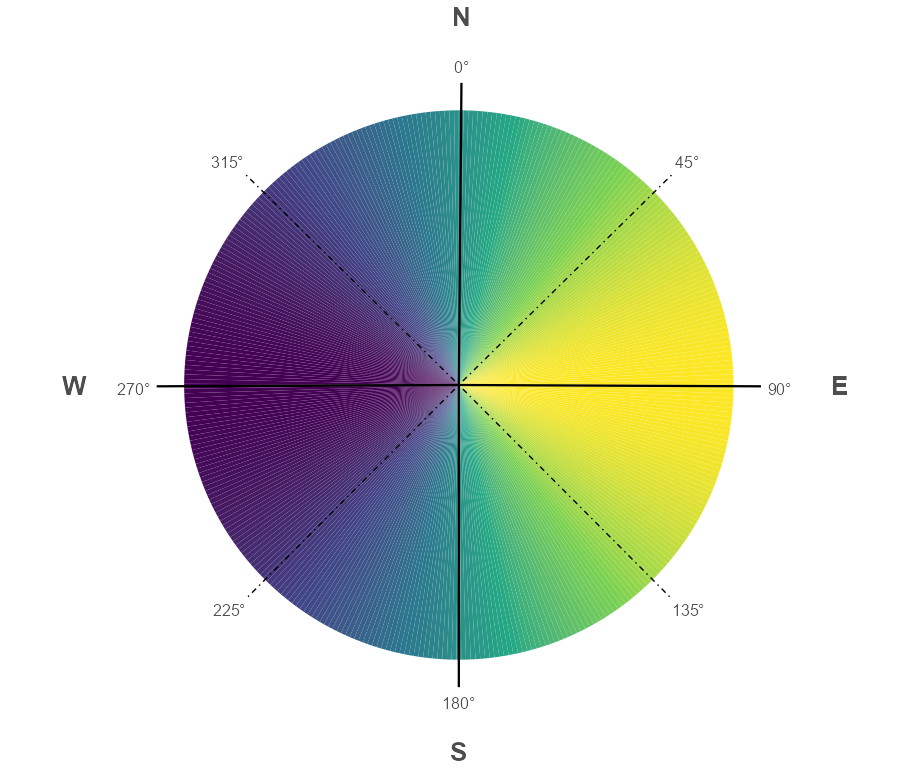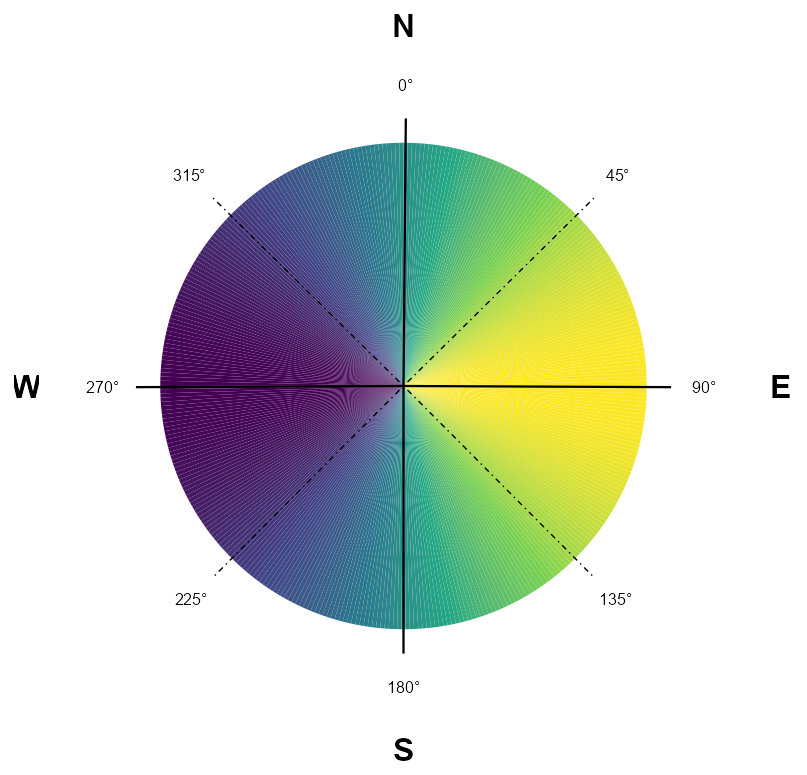How to add text outside the panel when using ggplot coord_polar()?
I want to create a plot that serves as a circular legend for a continuous variable. Additionally, I need to add text outside the panel, specifically below the x-axis (outside the circle). However, since I am using coord_polar(), functions like annotate() and geom_text() do not behave as they normally would. Does anyone have suggestions on how to address this issue?
Here is the data:
# DATA
aspect_class = data.frame(from = c(0, seq(22.5, 337.5, by = 45)),
to = c(seq(22.5, 337.5, by = 45), 360),
mid = seq(0, 360, by = 45),
class = c("North (0°-22.5°)",
"Northeast (22.5°-67.5°)",
"East (67.5° - 112.5°)",
"Southeast (112.5°-157.5°)",
"South (157.5°-202.5°)",
"Southwest (202.5°-247.5°)",
"West (247.5°-292.5°)",
"Northwest (292.5°-337.5°)",
"North (337.5°-360°)"))
degrees = seq(0, 360, by = 1)
values = sin(degrees * pi / 180)
aspect_legend_df = data.frame(degrees, values)
compas = data.frame(degrees = seq(0,315,45),
direction = c("N", "NE", "E", "SE", "S", "SW", "W", "NW"))
and the plot code:
# PLOT
ggplot() +
geom_tile(data = aspect_legend_df,
aes(x = degrees, y = 0, fill = values),
width = 1, height = 0.1) +
scale_x_continuous(breaks = compas$degrees,
labels = ~ paste0(.x, "\u00B0"),
name = "Aspect [°]") +
scale_fill_viridis_c() +
geom_vline(data = aspect_class[aspect_class$mid %in% c(0, 90, 180, 270),],
aes(xintercept = mid),
color = "black", linewidth = 0.8) +
geom_vline(data = aspect_class[!aspect_class$mid %in% c(0, 90, 180, 270, 360),],
aes(xintercept = mid),
color = "black", linewidth = 0.5, linetype = "dotdash") +
annotate(geom = "text", x = compas$degrees, y = 0.06, label = "") +
coord_polar(start = 0) +
theme_minimal() +
theme(legend.position = "none",
axis.title = element_blank(),
axis.text.y = element_blank(),
panel.grid.major = element_blank(),
panel.grid.minor = element_blank(),
axis.text.x = element_text(size = 12, color = "black"))
I want to get this:
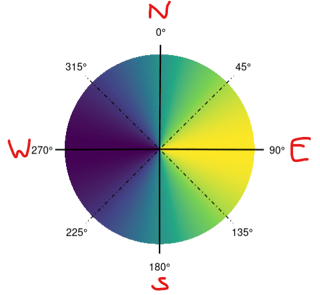
If I use annotate(geom = "text", x = compas$degrees, y = 0.06, label = compas$direction) + I get:
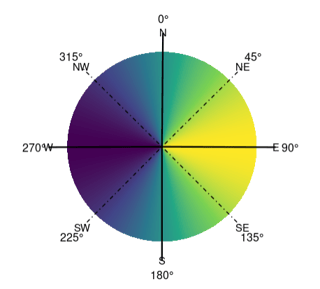
If I use geom_text(data = compas,aes(x = degrees, y = 0.06, label = direction), inherit.aes = FALSE, size = 5) I get:
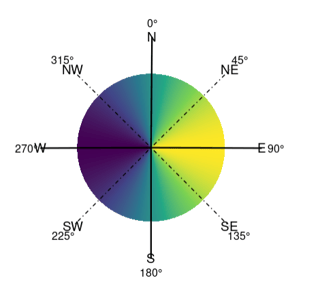
There are a few ways of doing this.
The simplest is just to specify the x axis labels with line breaks and spaces, though this does not allow you to customize the font size, color, etc.
For example, if you use your own code but specify the x axis as follows:
scale_x_continuous(breaks = compas$degrees,
labels = c("N\n0°", "45°", "90° E", "135°", "180°\nS",
"225°", "W 270°", "315°"))
You get
A somewhat more sophisticated approach would be to use library(ggtext) and employ element_markdown() to adjust sizes, spacing, color etc. I found I had to switch to coord_radial to get this working properly.
library(ggtext)
ggplot() +
geom_tile(data = aspect_legend_df,
aes(x = degrees, y = 0, fill = values),
width = 1, height = 0.1) +
scale_x_continuous(breaks = compas$degrees,
labels = c("<span style = 'font-size:20pt'>**N**</span><br><br><br>0°",
"45°",
"<span>90°</span>
<span style = 'color:white'>AA</span>
<span style = 'font-size:20pt'>**E**</span>", "135°",
"180°<br><br><br><span style = 'font-size:20pt'>**S**</span>",
"225°",
"<span style = 'font-size:20pt'>**W**</span>
<span style = 'color:white'>AA</span>270°", "315°"),
name = "Aspect [°]") +
scale_fill_viridis_c() +
geom_vline(data = aspect_class[aspect_class$mid %in% c(0, 90, 180, 270),],
aes(xintercept = mid),
color = "black", linewidth = 0.8) +
geom_vline(data = aspect_class[!aspect_class$mid %in% c(0, 90, 180, 270, 360),],
aes(xintercept = mid),
color = "black", linewidth = 0.5, linetype = "dotdash") +
annotate(geom = "text", x = compas$degrees, y = 0.06, label = "") +
coord_radial(start = 0, expand = FALSE) +
theme_minimal() +
theme(legend.position = "none",
axis.title = element_blank(),
axis.text.y = element_blank(),
panel.grid.major = element_blank(),
panel.grid.minor = element_blank(),
axis.text.theta = element_markdown(size = 12))
However, for ultimate control it might be best to draw the labels on using patchwork:
library(grid)
library(patchwork)
p <- ggplot(aspect_legend_df, aes(degrees, 0, fill = values)) +
geom_tile(width = 1, height = 0.1) +
geom_vline(xintercept = seq(0, 270, 90), lwd = 0.8) +
geom_vline(xintercept = seq(45, 315, 90), lwd = 0.5, linetype = "dotdash") +
scale_x_continuous(breaks = seq(0, 315, 45), labels = ~sprintf("%d°", .x)) +
scale_y_continuous(limits = c(-0.05, 0.06)) +
scale_fill_viridis_c(guide = "none") +
coord_polar(start = 0) +
theme_void() +
theme(axis.text.x = element_text(size = 12, color = "black"))
NESW <- lapply(c("N", "E", "S", "W"), function(x) {
wrap_elements(textGrob(x, gp = gpar(cex = 2, font = 2)))
})
plot_spacer() + NESW[[1]] + plot_spacer() +
NESW[[4]] + p + NESW[[2]] +
plot_spacer() + NESW[[3]] + plot_spacer() +
plot_layout(heights = c(1, 30, 1), widths = c(1, 30, 1))
- Create a Grouping Column/Variable from other Columns in R
- Specify the height of the bars in the gglikert function in R
- modelsummary modelplot: change linewidth
- How to create a conditional panel using a reactive object that is passed from another module?
- renderHighchart output not displaying in Shiny App
- How can I specify GeoTiff configuration of PixelIsPoint when exporting a raster using R package terra?
- Create a list from a dataframe in R
- Fast way of converting large list to dataframe
- rintrojs only shows first dialog in Safari
- Automatically read a column of lowercases True and False as logical
- How do I add counts to a stacked bar graph?
- Counting the number of rows between each pair of months?
- Plot multiple normalized stock charts from different dates into a single plot
- Select columns based on string match - dplyr::select
- Looking for a more efficient way to replace matrix elements
- custom R function with group argument does not work while using the filter
- ggsurvplot function, risk table alignment problem
- plot running average in ggplot2
- Calling variable in df within function
- How to find position of running minimum (runMin) in a vector in R?
- Using httr2::last_response() in conjunction with purrr::possibly()
- Cropping a raster using terra does not return the expected extent
- Can janitor::clean_names be used on only certain columns in a data frame?
- Efficient way of row binding time series in a data.table, with correctly sorted timestamps
- Defining optional arguments in R when more complex function
- Can I change the cursor in plotly only when hovering over points?
- Issue Loading RStoolbox: "Cannot find proj.db" Error
- Filter CSV files for specific value before importing
- Matching the same lines from 2 different files and 2 columns
- Conditional coloring and outer borders in pdf KableExtra table in R
